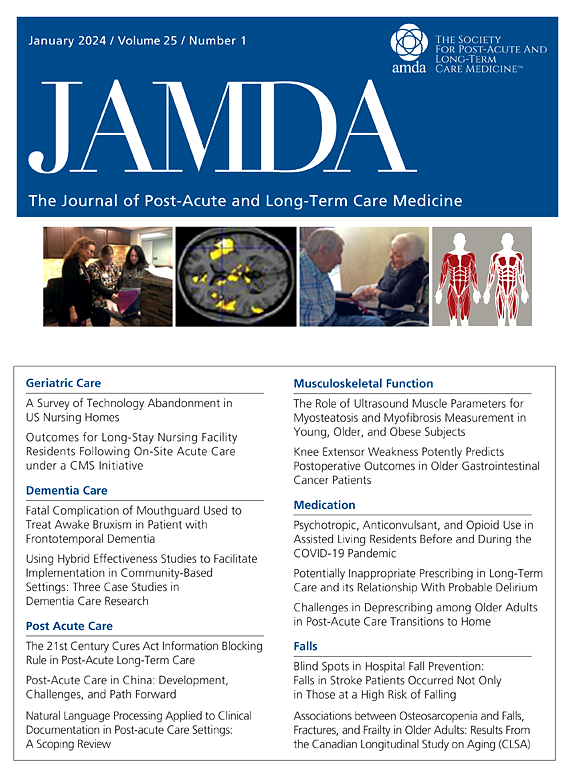长期护理中精神分裂症患者的卫生保健使用、护理环境和死亡地点
IF 3.8
2区 医学
Q2 GERIATRICS & GERONTOLOGY
Journal of the American Medical Directors Association
Pub Date : 2025-06-30
DOI:10.1016/j.jamda.2025.105719
引用次数: 0
摘要
目的:确定患有和非精神分裂症的长期护理(LTC)居民在生命最后一年的卫生保健环境和死亡地点是否存在差异。设计:使用卫生管理数据的回顾性队列研究。环境和参与者:2010年1月1日至2019年12月31日期间在安大略省死亡的所有成年人,他们在死亡前1年住在LTC家中,并因自然原因死亡。方法:使用一种经过验证的管理数据算法来确定精神分裂症。我们使用描述性统计、负二项回归和逻辑回归来比较精神分裂症患者和非精神分裂症患者在生命最后一年的健康特征、医疗保健使用和死亡地点。结果:在135,560名LTC居民中,5670名(4.2%)被诊断为精神分裂症。患有精神分裂症的LTC居民平均早死7年(标准化差异= 0.75),但更有可能没有记录的慢性健康状况(标准化差异= 0.19)。经年龄、性别、死亡原因和死亡年份校正后,精神分裂症患者在生命最后一年的住院率(校正比率比= 1.22,95%可信区间= 1.17-1.26)和急诊就诊率(校正比率比= 1.14,95%可信区间= 1.10-1.18)显著高于其他患者。这一发现在与精神健康和非精神健康相关的住院和急诊就诊中都有观察到。患有精神分裂症的LTC住院患者在精神健康相关住院期间(标准化差异= 0.21)或非精神健康相关住院期间(标准化差异= 0.15)死亡的可能性也更大,LTC住院患者死亡的几率更低(调整优势比,0.83;95%置信区间为0.78-0.88)。结论和意义:与没有精神分裂症的居民相比,精神分裂症的LTC居民有更高的急性护理使用率,更有可能在医院死亡。需要更多的研究来了解精神分裂症LTC居民的护理规定的差异,并了解LTC设施如何满足这一弱势群体的独特需求。本文章由计算机程序翻译,如有差异,请以英文原文为准。
Health Care Use, Care Settings, and Location of Death for People With Schizophrenia in Long-Term Care
Objective
To determine if health care settings in the last year of life and location of death differ between long-term care (LTC) residents with and without schizophrenia.
Design
A retrospective cohort study using health administrative data.
Setting and Participants
All adults who died in Ontario between January 1, 2010, and December 31, 2019, who were living in LTC homes 1 year before death, and who died of natural causes.
Methods
Schizophrenia was ascertained using a validated administrative data algorithm. We used descriptive statistics, negative binomial regression, and logistic regression to compare health characteristics, health care use, and location of death for individuals with and without schizophrenia in the last year of life.
Results
Of 135,560 total LTC residents, 5670 (4.2%) had a diagnosis of schizophrenia. LTC residents with schizophrenia died on average 7 years earlier (standardized difference = 0.75) yet were more likely to have no recorded chronic health conditions (standardized difference = 0.19). Those with schizophrenia had significantly higher rates of hospitalizations (adjusted rate ratio = 1.22, 95% confidence interval = 1.17–1.26) and emergency department visits (adjusted rate ratio = 1.14, 95% confidence interval = 1.10–1.18) in the last year of life, adjusted for age, sex, cause of death, and year of death. This finding was observed for both mental health–related and non–mental health–related hospitalizations and emergency department visits. LTC residents with schizophrenia were also more likely to die during a mental health–related (standardized difference = 0.21) or non–mental health–related (standardized difference = 0.15) hospitalization, with lower odds of dying in LTC (adjusted odds ratio, 0.83; 95% confidence interval, 0.78–0.88).
Conclusions and Implications
LTC residents with schizophrenia have higher rates of acute care use and are more likely to die in hospital compared with residents without schizophrenia. More research is necessary to understand differences in care provisions for LTC residents with schizophrenia and understand how LTC facilities can meet the unique needs of this vulnerable population.
求助全文
通过发布文献求助,成功后即可免费获取论文全文。
去求助
来源期刊
CiteScore
11.10
自引率
6.60%
发文量
472
审稿时长
44 days
期刊介绍:
JAMDA, the official journal of AMDA - The Society for Post-Acute and Long-Term Care Medicine, is a leading peer-reviewed publication that offers practical information and research geared towards healthcare professionals in the post-acute and long-term care fields. It is also a valuable resource for policy-makers, organizational leaders, educators, and advocates.
The journal provides essential information for various healthcare professionals such as medical directors, attending physicians, nurses, consultant pharmacists, geriatric psychiatrists, nurse practitioners, physician assistants, physical and occupational therapists, social workers, and others involved in providing, overseeing, and promoting quality

 求助内容:
求助内容: 应助结果提醒方式:
应助结果提醒方式:


